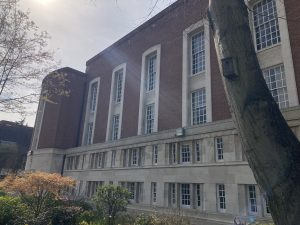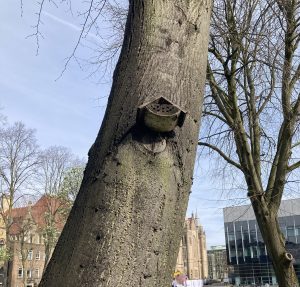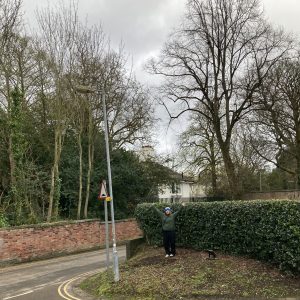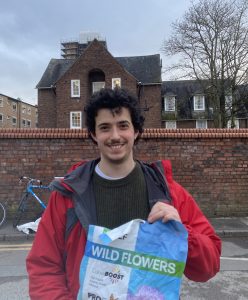
Have You Noticed? A Journey Towards a Nature-Positive Campus
Blog by Jacob Spensley, Final Year Environmental Sustainability Project Student
Biodiversity decline is occurring rapidly across the UK with findings from recent surveys (State of Nature Partnership) shining a light on the severe losses, including;
- 41% of species have declined since the 1970s
- one in six UK species is at real risk of being lost
There are several root causes of this, including; urbanisation, climate change, pollution, and agriculture. Agriculture has the most detrimental impact, defined as a loss and fragmentation of natural habitats through the intensification of management practices to maximise output and meet growing demands at the expense of wildlife – this is evident in a shocking loss of 97% of wildflower meadows since the 1930s.
The countryside, associated with vibrant greens and the sound of birds, has become largely quiet, transformed into uniform cropland and becoming inhospitable to many native species. Whilst the Department for Environment, Food and Rural Affairs (DEFRA) needs to work with farmers to agree and incentivise appropriate nature-based solutions for the countryside, urban areas also have a key role to play.
Green spaces are increasingly designed with biodiversity in mind, and studies have demonstrated their ability to host biodiverse communities. Baldock et al. (2015) found that urban bee diversity was higher than in farmland and hosted as many rare species as nature reserves. As a result, the University is striving for a more sustainable, biodiverse campus.
Commitments and Partnerships
In 2014 the University developed ‘The Living Campus’ plan, the first step toward a greener campus. The University then became a founding member of the Nature Positive Universities Alliance at the United Nations (UN) Biodiversity Conference (COP15) in 2022. The alliance now consists of 117 Universities from across the globe, all of which have pledged to become nature positive and promote biodiversity to the community through student ambassadors.
The University’s goals are summarised in the biodiversity conservation strategy ‘Our Sustainable Future‘. Their commitments include a goal of 20% net gain to biodiversity in all major construction projects, as well as increasing green space on campus by 10% compared to 2018 over a 10-year period.
Take a look

Bird Box located outside the Main Library
To achieve this, the University is employing various strategies, altering gardening practices and creating new green areas for students and staff to enjoy. If you look carefully enough around campus, you might see bird boxes; there are a few perched on trees outside the main library! High up in the trees of Fallowfield Campus, near Owens Park, there are even bat boxes. These were installed to house a small family of bats which made their home inside one of the buildings.
On the main campus, the Michael Smith Quad was transformed into a wildlife haven and actively promotes biodiversity – its pond hosts pond skaters, dragon flies and even frogs. Although it lost some of its charm over the last few years, plans are in place to revamp the space, for students, staff and wildlife to enjoy. The Quad demonstrates how campus can host vibrant biodiverse spaces, providing natural beauty so often lacking in urban spaces.

Insect house by the Alan Gilbert Square
Tucked away in a corner by the Williamson building and outside the Library, you can find small insect houses; these are designed for solitary bees, who lay their eggs inside. If you look closely, you may be able to tell if they are inhabited; if a whole is filled in, there is likely a guest inside.
If bugs are not your thing, Manchester has far more to offer, hosting 1,500 trees across the Oxford Road Campus, North Campus, and Whitworth Park. For those who want to engage with campus trees, there is an interactive tree walk, which provides information about each tree as you go along – a perfect way to connect with nature and learn about biodiversity on campus. To ensure Manchester’s trees continue to thrive, any tree removed on campus is replaced with two semi-mature trees either on or off campus.
Other initiatives such as ‘No Mow May’ represent a way in which the University, but also parks and even individuals across the UK, are reclaiming a little bit of nature. By refraining from mowing throughout May, many invertebrate species, including pollinators, have access to the flowers, which are given the time and space to blossom. The University has vast amounts of short mown grass, therefore designating areas to this initiative provides much needed respite to our pollinating populations. To further this cause, the University has begun to convert some of the extensive grassland into urban meadows, these can be seen by the Williamson building and behind the Main library. The University has also gone peat-free as of 2023, a big step forward in terms of reducing its broader ecological impact, demonstrating the University’s ongoing commitment to a greener, more biodiverse campus.
Nestled atop the Rutherford building, and the Whitworth Art Gallery are beehives. Although out of site, some of the bees you see around campus likely live there. This represents an important part of the University’s sustainability strategy, contributing to the pollinator presence on campus. To further enhance this, plans are underway for an on-campus allotment. It will act as a hotspot for biodiversity, supporting rich plant diversity, attracting bees, butterflies and much more. Some initiatives may be hidden and out of site but there is no doubt the University is creating a greener campus.
Green Infrastructure and Development
The University is also investing in green infrastructure; their new projects are built with careful consideration, assessing how it will not only prevent loss of biodiversity but how it can be harnessed to promote a sustainable campus. Brunswick Park is a large green space and recent development, it represents a key part of the University’s sustainability strategy. Prior to redevelopment the space provided little for wildlife and for users, now the extensive green space hosts trees, grassland, and small areas of wildflowers.
Another part of the University’s strategy, which you may not have spotted from the ground, are the green roofs sitting atop the Whitworth Art Gallery and National Graphene Building. They provide habitat and connectivity to the campus, as well as insulating buildings, reducing heat transfer by 80%, and increasing roof life spans. A green wall also sits sprawled across the Schuster Building, providing a vital habitat for pollinators with similar benefits to the green roofs.
These infrastructures are a great solution for grey urban areas with little space for nature and the University plans on taking advantage of this. Whilst approximately a third of the Fallowfield Campus habitat is ‘poor’ in terms of ecological condition according to the ‘Nature Positive Universities Pledge’, the planned redevelopment holds potential for green space enhancement, in line with the University’s biodiversity goals. These innovative developments underscore how the University is increasing the ecological value of its campuses for a green and sustainable future.

Wildflower planting on the Fallowfield campus
How can you to get involved?
There are many ways to get involved with Manchester’s biodiversity, whether it be directly through the University or other volunteering organisations. The University has a range of opportunities and places where you can engage with and enjoy its green spaces, and here is where to find a few of these! The Tree Musketeers, a student-led volunteering group, take part in conservation initiatives, including (unsurprisingly) tree planting. The Firs Botanical Gardens, located on the Fallowfield Campus, also offers volunteering opportunities. It hosts a small, wooded area, an uninhabited owl box awaiting its tenants, a pond home to newts and invertebrates and raised beds, which are tended to daily by volunteers.

Wildflower planting on the Fallowfield campus
Just around the corner from the Firs, new wildflower areas have been sown. As part of my final year project, (on university green space and campus biodiversity), I collaborated with the landscaping team. We selected appropriate locations for wildflowers that would ensure they were seen, enjoyed and beneficial to wildlife. The landscaping team provided the wildflower seed, and in late March, we planted them. As of the time of writing they are yet to flower, but if all goes well, they will provide aesthetic and ecological value to the Fallowfield Campus. This is a great example of the potential benefits of student involvement in campus green space.
There is a lot more that can be done to improve the value of green space on campus and all possible avenues must be explored to adequately support biodiversity. However, as of the most recent report on the University’s goals, they are on track with all biodiversity objectives, in fact, they are on course to complete all their sustainability goals! With continued commitment and community engagement the future of the University will be green and biodiverse.
References
Baude, M. et al. (2016) ‘Historical Nectar Assessment Reveals the Fall and Rise of Floral Resources in Britain’, Nature, 530(7588), pp. 85-88. Available at: https://doi.org/10.1038/nature16532.
Oberndorfer, E. et al. (2007) ‘Green Roofs as Urban Ecosystems: Ecological Structures, Functions, and Services’, BioScience, 57(10), pp. 823-833. Available at: https://doi.org/10.1641/b571005.
State of Nature (2023) State of Nature. State of Nature Partnership. Available at: https://stateofnature.org.uk/wp-contenUuploads/2023/09/TP25999-State-of-Nature-mainreport_2023_FULL-DOC-v12.pdf (Accessed: 11 April 2024 ).
Zheng, X. et al. (2022) ‘An Experimental Study on the Thermal and Energy Performance of Selfsustaining Green Roofs Under Severe Drought Conditions in Summer’, Energy and Buildings, 261 , pp. 111953-111953. Available at: https://doi.org/10 .1016/j.enbuild.2022.111953.
Al Statement
I used Al (ChatGPT 3.5) to generate some key themes at the beginning of my project.

0 Comments